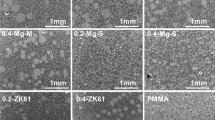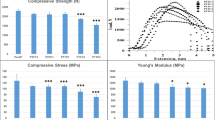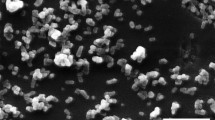Abstract
The nature of the orthopedic implant surface affects the interaction between cells and subsequent bone formation. The bone/cement interface in cement-held prostheses is considered to be the main cause of fracture leading to implant revision. It is thought that the introduction of a bioactive phase, such as hydroxyapatite (HA), to cement may permit a stronger implant by encouraging direct bone apposition rather than encapsulation of the implant by fibrous tissue. Thus, a poly(methylmethacrylate) (PMMA) cement incorporating 17.5% HA by weight has been investigated. In this study, in order to analyze the interaction at the cellular level, the in vitro biological response of the HA/PMMA to a similar PMMA without HA incorporation has been studied. Primary human osteoblast-like cells (HOB) were used as they are a model of the cell type the cements might encounter in vivo. Cell proliferation and growth were assessed by measurement of total cellular DNA and tritiated thymidine ([3H]-TdR) incorporation. Alkaline phosphatase (ALP) production was measured as an indicator of HOB phenotype upon the cements. The results showed that HA/PMMA was a better substrate for HOB cells, resulting in increased proliferation and ALP activity. Scanning electron microscopy (SEM) and transmission electron microscopy (TEM) showed that HOB cells cultured on the HA-filled PMMA preferentially anchored to HA particles exposed at the cement surface, with a close intimacy observed between HA and HOB cells.
Similar content being viewed by others
References
E. P. Lautenschlager, S. I. Stupp and J. C. Keller, Func. Behav. Orthop. Biomater. 2(1984) 87.
S. Downes, M. V. Kayser, G. Blunn and S. Y. Ali, Cells Mater. 1(1991) 171.
T. A. Gruen, Clin. Orthop. Rel. Res. 141(1979) 17.
A. Sogal and S. F. Hulbert, Bioceramics 5(1992) 213.
J. Huang, L. DiSilvio, M. Wang, K. E. Tanner and W. Bonfield, J. Mater. Sci.: Mater. Med. 8(1997) 1.
L. DiSilvio, PhD Thesis, University of London, 1995.
L. DiSilvio, M. J. Dalby and W. Bonfield, J. Mater. Sci.: Mater. Med. 9(1998) 845.
G. Stein and J. Lianin “Endocrine reviews” edited by M. Node (Academic Press, London, 1993) p. 424.
W. Bonfield, Biol. Biomech. Perf. Biomater. (1986) 299.
L. L. Hench, J. Amer. Ceram. Soc. 74 (1991) 1487.
Author information
Authors and Affiliations
Rights and permissions
About this article
Cite this article
Dalby, M.J., Di Silvio, L., Harper, E.J. et al. In vitro evaluation of a new polymethylmethacrylate cement reinforced with hydroxyapatite. Journal of Materials Science: Materials in Medicine 10, 793–796 (1999). https://doi.org/10.1023/A:1008907218330
Issue Date:
DOI: https://doi.org/10.1023/A:1008907218330




